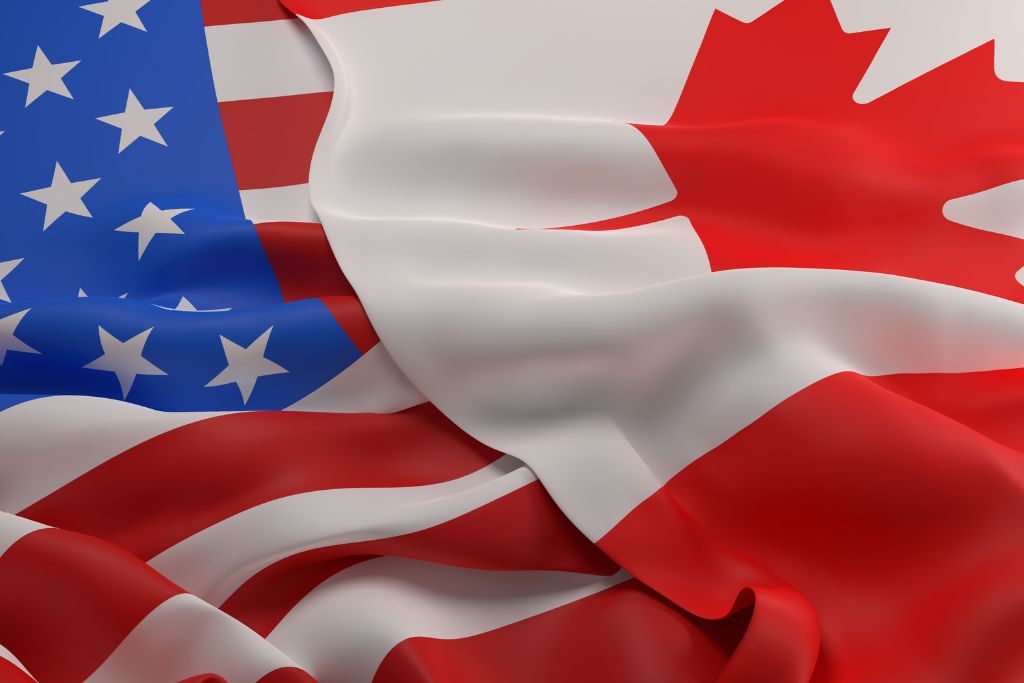Stepping into a new chapter of life in the United States can be both exciting and overwhelming. As I leave behind the familiar landscapes of Canada, I’m faced with a multitude of legal, financial, and logistical considerations that need careful planning. Each detail is crucial to ensure that this major transition is as smooth as possible.
Navigating the intricacies of moving from Canada to the USA involves understanding complex immigration rules, tax implications, and lifestyle adjustments.
With the support of experts like 49th Parallel Wealth Management, I feel confident that my financial and personal needs are well managed. They offer personalized services such as retirement planning, tax optimization, and wealth management to help me settle comfortably into my new life.
Understanding the Transition Process
 alt="Moving from Canada to USA Checklist"/>
alt="Moving from Canada to USA Checklist"/>Immigration and Legal Requirements
- Visa and Residency:
I make sure to have the correct visa or green card. It’s crucial to research the requirements and timelines for obtaining permanent residency or citizenship in the U.S. - Legal Documentation:
Gathering essential documents is key. I need to secure passports, birth certificates, and marriage certificates and consult with an immigration lawyer if necessary.
Financial and Tax Considerations
- Tax Obligations:
Understanding cross-border tax implications is necessary. I need to address U.S. and Canadian tax responsibilities, including handling retirement accounts and foreign income. - Currency and Banking:
It’s important to plan for currency conversion and set up U.S. bank accounts to streamline my financial transactions.
Logistical and Lifestyle Factors
- Housing:
I decide whether to sell or rent out my Canadian property and research housing options in my U.S. destination. - Healthcare and Insurance:
I look into U.S. health insurance plans and compare them with my current coverage. - Employment and Education:
Considering job opportunities is essential, and if applicable, I research schools and childcare options for my family.
Your Ultimate Checklist for a Smooth Transition
As I prepare for my move, I’ve identified several key steps to ensure a smooth transition.
- Confirming My Immigration Status: I need to secure the right visa or green card by consulting an immigration lawyer to clear any uncertainties.
- Financial Planning and Cross-Border Tax Strategy: I’ll notify my financial advisor and review cross-border tax obligations. Understanding the treatment of my Canadian retirement accounts, investments, and assets is crucial. Considering strategies to optimize my tax situation using available tax treaties is a priority.
- Updating My Residency Details: Informing Canadian authorities about my change of residency is necessary, along with updating my address with banks, service providers, and government agencies.
- Managing Banking and Currency Needs: Opening a U.S. bank account and planning for currency exchange will ensure I have ready access to funds.
- Securing Healthcare and Insurance: Researching and enrolling in a U.S. health insurance plan is essential. I also need to understand how my Canadian coverage may be affected.
- Planning My Housing Transition: I’ll decide whether to sell, rent, or keep my Canadian property. It’s time to begin the search for a new home in the U.S., considering location, cost of living, and local amenities.
- Addressing Employment and Education: Looking into job markets and career opportunities in my new location is on the agenda. Researching schools and educational resources is also important if I’m moving with children.
- Updating Legal and Estate Planning Documents: I’ll revise my will, power of attorney, and other legal documents to reflect my new residency. Consulting with legal professionals experienced in cross-border estate planning is wise.
- Preparing for Cultural and Lifestyle Adjustments: Familiarizing myself with U.S. customs, cost of living differences, and local community resources is part of the preparation. Joining local groups or online forums will ease the transition.
Actionable Tips and Best Practices
I find that having a solid timeline really eases the transition. Planning each step, from getting my visa to settling into my new home, helps keep me on track. It’s wise to consult with cross-border specialists for immigration, financial, and tax guidance. They help simplify the process significantly.
I make use of digital tools and apps to manage my tasks efficiently. Keeping all documentation organized is crucial—I ensure I have copies of essential documents ready for reference or audits. Staying updated with changes in immigration and tax laws via government websites ensures I’m always on the right path.
A Successful Transition
When I moved from Toronto to San Francisco, I ensured a smooth transition by planning every detail. Securing a green card was my first step, and consulting an immigration expert made the process efficient. Opening a U.S. bank account was essential, so I transferred part of my retirement savings with guidance from a cross-border tax advisor. Selling my Canadian condo allowed me to finance my new home, which made settling easier.
I enrolled in a local health plan and meticulously updated all legal documents to reflect my new residency. This proactive approach, along with professional consultations, enabled me to focus on building my life in the U.S. without unnecessary stress.
Expert Opinions and Resources
To navigate a cross-border move smoothly, I rely on the expertise of professionals who understand both Canadian and U.S. systems. Their guidance helps avoid costly errors. Maintaining regular contact with my financial, legal, and immigration advisors is crucial to adapt plans when necessary.
I trust reputable resources for the most current information. Websites like USCIS provide reliable details on immigration and residency needs.
For those interested in estate planning, I recommend exploring the Estate Planning for Green Card Holders guide. Additionally, insights from the Framingham Heart Study highlight important lessons for community welfare and financial health.
Conclusion
Moving from Canada to the USA is a significant journey that requires careful preparation. I ensure that every step is streamlined and efficient. Here’s how I approach the essential aspects:
- Legal and Immigration: Navigating immigration laws is crucial. By keeping all documents ready, I make sure this part goes smoothly.
- Financial Planning: Proper financial strategy is vital. I manage currency exchanges and tax implications to keep my finances in order.
- Residency and Logistics: Updating residency details is a top priority, along with organizing logistics for day-to-day living.
My detailed approach means fewer surprises along the way. Using expert resources like 49th Parallel Wealth Management provides added support and knowledge. Through proper planning, I look forward to settling into a new chapter in the USA smoothly and successfully.
Frequently Asked Questions
What are the necessary documents for relocating from Canada to the United States?
When moving from Canada to the USA, I need several key documents. These include a valid passport, a visa appropriate to my immigration status, and possibly an employment offer. I should also have my Social Insurance Number (SIN) and health records handy. Proof of financial support and documentation for any accompanying family members are also important.
What tax implications should Canadians consider when moving to the U.S.?
As a Canadian moving to the U.S., I’m subject to different tax rules. It’s essential to understand both Canadian and U.S. tax obligations. According to this guide, I need to consider how my Canadian assets, such as a home or retirement savings, are taxed in the U.S. Consulting with a cross-border tax advisor can be very helpful.
How can one permanently move from Canada to the USA?
To permanently relocate from Canada to the USA, I need to secure the right type of visa or green card. Paths include employment-based sponsorship, family sponsorship, or investment. Understanding the requirements and processes for each is crucial, and early preparation is key.
What are the employment-related considerations for Canadians wishing to work in the USA?
If I’m planning to work in the USA, I must understand U.S. employment regulations. Securing a work visa, such as a TN visa under NAFTA, is often necessary. A checklist detailing financial preparations and licenses can help streamline the process.
How does one transfer personal belongings from Canada to the United States?
When transferring belongings to the USA, I must decide between shipping services or moving them myself. Each option has different costs and regulations. Keeping an inventory and understanding customs requirements can facilitate a smoother transition.
What are the challenges of relocating to the USA from Canada without a job offer?
Moving to the USA without a job offer can be challenging. Immigration options might be limited and financial planning becomes crucial. I should assess my savings, budget for living expenses without employment, and explore short-term rental housing.


